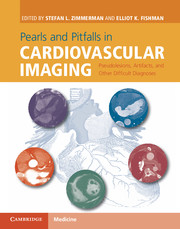 Pearls and Pitfalls in Cardiovascular Imaging
Pearls and Pitfalls in Cardiovascular Imaging Book contents
- Frontmatter
- Contents
- List of contributors
- Preface
- Section 1 Cardiac pseudotumors and other challenging diagnoses
- Section 2 Cardiac aneurysms and diverticula
- Section 3 Anatomic variants and congenital lesions
- Section 4 Coronary arteries
- Section 5 Pulmonary arteries
- Section 6 Cardiovascular MRI artifacts
- Case 47 Inappropriate inversion time selection for late gadolinium enhancement imaging
- Case 48 Pseudothrombus on dark blood images
- Case 49 Gibbs ringing artifact
- Case 50 Aliasing artifact in phase-contrast cardiac MR
- Case 51 Pseudostenoses on MR angiography from susceptibility artifact
- Case 52 Pseudostenosis on time-of-flight magnetic resonance angiography
- Case 53 Maki effect
- Section 7 Acute aorta and aortic aneurysms
- Section 8 Post-operative aorta
- Section 9 Mesenteric vascular
- Section 10 Peripheral vascular
- Section 11 Veins
- Index
- References
Case 47 - Inappropriate inversion time selection for late gadolinium enhancement imaging
from Section 6 - Cardiovascular MRI artifacts
Published online by Cambridge University Press: 05 June 2015
- Frontmatter
- Contents
- List of contributors
- Preface
- Section 1 Cardiac pseudotumors and other challenging diagnoses
- Section 2 Cardiac aneurysms and diverticula
- Section 3 Anatomic variants and congenital lesions
- Section 4 Coronary arteries
- Section 5 Pulmonary arteries
- Section 6 Cardiovascular MRI artifacts
- Case 47 Inappropriate inversion time selection for late gadolinium enhancement imaging
- Case 48 Pseudothrombus on dark blood images
- Case 49 Gibbs ringing artifact
- Case 50 Aliasing artifact in phase-contrast cardiac MR
- Case 51 Pseudostenoses on MR angiography from susceptibility artifact
- Case 52 Pseudostenosis on time-of-flight magnetic resonance angiography
- Case 53 Maki effect
- Section 7 Acute aorta and aortic aneurysms
- Section 8 Post-operative aorta
- Section 9 Mesenteric vascular
- Section 10 Peripheral vascular
- Section 11 Veins
- Index
- References
Summary
Imaging description
Inappropriate selection of the inversion time (TI) in late gadolinium enhancement (LGE) cardiac MRI (CMR) examinations results in incomplete suppression of the myocardium. Most frequently encountered is the selection of a TI that is slightly too short, resulting in a subendocardial “ring of hypointensity” and a mid-myocardial zone of hyperintensity (Figures 47.1 and 47.2). These artifacts may mimic true mid-myocardial delayed enhancement that can be seen in pathologic conditions such as sarcoidosis or dilated cardiomyopathy (Figure 47.3). In a less commonly encountered clinical scenario, suppression of abnormal myocardium (amyloidosis is the prototypical example) will cause hypointensity of abnormal myocardium. This will result in the poor quality of delayed enhancement images that is a hallmark of patients with amyloidosis (Figure 47.4).
Importance
Two potential pitfalls result from incorrect inversion time selection. First, incorrect nulling of the myocardium reduces the conspicuity of true myocardial delayed enhancement, potentially hiding underlying pathology, resulting in a falsenegative result. Second, incomplete nulling due to a short inversion time, if not recognized as artifact, can be erroneously interpreted as diffuse mid-myocardial LGE, leading to a falsepositive result. The interpreting radiologist must be familiar with the appearance of deviations of the TI selection, and be aware of underlying conditions, particularly amyloidosis, that can cause difficulty in selecting the correct TI time.
Typical clinical scenario
TI is selected to provide maximal contrast between normal and abnormal myocardium by completely nulling any signal from normal myocardium. TI selection determines the sensitivity for the detection of myocardial damage. The actual TI time needed for normal myocardial suppression depends on multiple factors, including the time after contrast injection, renal elimination of contrast, patient size, cardiac output, contrast dose and contrast agent. A typical approach for TI selection is the use of a “TI scout” sequence, which is typically an ECG-gated post-contrast sequence with images acquired at multiple delay times after an initial 180 degree inversion pulse, resulting in different TI contrasts throughout the cardiac cycle.
Information
- Type
- Chapter
- Information
- Pearls and Pitfalls in Cardiovascular ImagingPseudolesions, Artifacts, and Other Difficult Diagnoses, pp. 146 - 149Publisher: Cambridge University PressPrint publication year: 2015